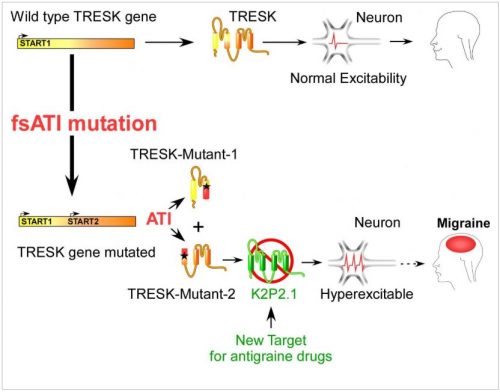Researchers have identified a new mechanism that causes migraines. They discovered how a mutation causes a dysfunction within a protein which undermines neuronal electrical activity. This weakening of neuronal electrical activity induces migraines.
The researchers, from Inserm, CNRS, Universitat de Barcelona, Weill Cornell Medicine, and Université Côte d’Azur wrote about their study in the journal Neuron (citation below). CNRS stands for the Centre National de la Recherche Scientifique (National Center for Scientific Research) in France.
The authors say that their discovery opens a new path for research and development into anti-migraine medication.
Migraines – no effective curative treatment
Fifteen percent of adults worldwide suffer from migraine. Despite this huge number, there is no long-term, effective, curative treatment for it.
Many factors are linked to the onset and occurrence of migraine. Electric hyperexcitability in sensory neurons, for example, is one factor.
Specific proteins control the electrical activity of sensory neurons. These proteins generate the TRESK channel, a type of ion channel which inhibits electrical activity. Ion channels are pore-forming membrane proteins. They allow ions to pass through the channel pore.
The research team showed that a mutation in the gene that encodes this proteins causes a split between two dysfunctional proteins. One targets other ion channels (K2P2.1) while the other is inactive. They induce a great stimulation of neuronal electrical activity which subsequently leads to migraines.

Mechanism underlying migraines
Previous studies had demonstrated the hereditary nature of migraines. However, no study, apart from this one, had ever shown what the mechanism underlying them was.
By demonstrating what the TRESK split induces, i.e., hyperexcitability in sensory neurons and subsequently migraines, the teams’ work opens a new research path for migraine medication development.
The research team has submitted a patent application: “The scope is targeting K2P2.1 channels to reduce the electrical activity of neurons and prevent migraines from being triggered.”
The researchers also believe that the mechanism they discovered might apply to other genetic diseases. They, therefore, suggest that further research on other genetic diseases and their diagnoses should include data from the mechanism they discovered.
Citation
“Migraine-Associated TRESK Mutations Increase Neuronal Excitability through Alternative Translation Initiation and Inhibition of TREK,” Perrine Royal, Joshua Levitz, Guillaume Sandoz, Anne Baron, Florian Lesage, Xavier Gasull, Brigitte Wdziekonski, Alba Andres-Bilbe, Sébastien Schaub, Pablo Ávalos Prado, and Clément Verkest. Neuron. Published: December 17, 2018. DOI:https://doi.org/10.1016/j.neuron.2018.11.039.
